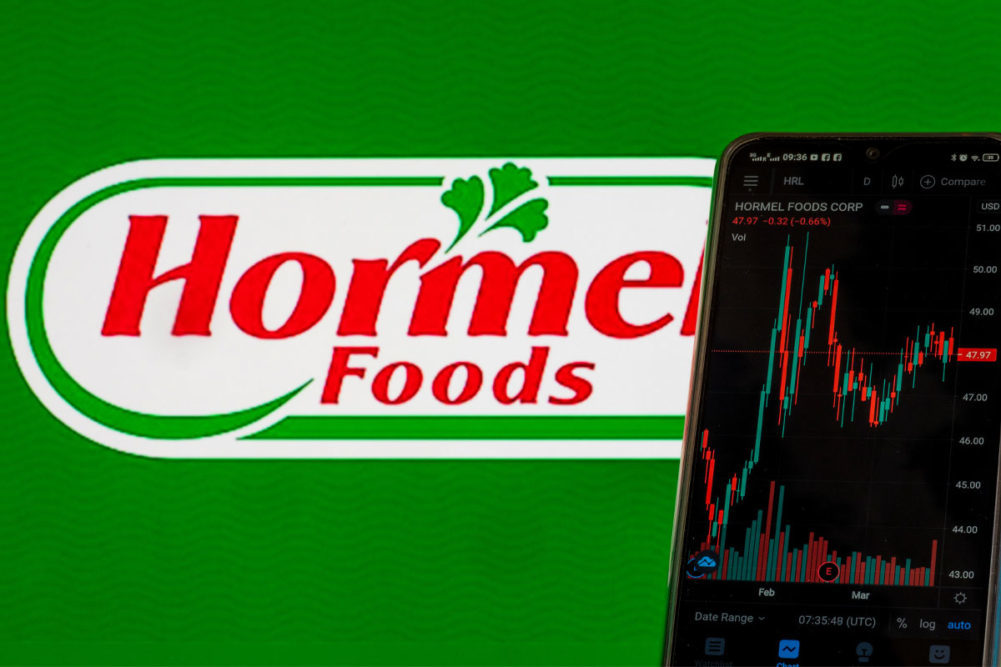AUSTIN, MINN. — The strategic rationale for companies to have a diverse portfolio of businesses is to better manage risk — Weakness in one category may be offset by strength in others.
Hormel Foods Corp., through its animal protein, peanut butter and snack nuts businesses, has adopted such a strategy, but learned during its most recent quarter that even the most diverse portfolio can’t overcome weakness in multiple categories.
Volatile pork prices combined with a slower-than-expected recovery for turkey products following last year’s avian influenza (AI) outbreak and weakness in China all combined to pressure results and lead management to reduce the company’s full-year sales guidance.
Net income for the fiscal third quarter ended July 30 was $162.7 million, equal to 30¢ on the common stock, and down from the same period the year before when the company earned $218.8 million, or 4o¢ per share. Additional items weighing on earnings included a $70 million ruling against Hormel Foods in an arbitration case.
Quarterly sales fell 2.3% to $2.96 billion from $3.03 billion the year before.
In Hormel’s Retail business unit, its largest, sales fell 1.7% to $1.89 billion from $1.92 billion the year before, and segment profit fell 7.3% to $151 million from $163 million. Segment net sales declined due to the difficult comparison from high levels of demand for Skippy spreads last year and lower market-driven pricing on raw bacon items, according to the company. Segment profit declined due to unfavorable mix and increased brand investments, partially offset by the benefit from pricing actions across the portfolio, improved bacon volumes and higher equity in earnings from MegaMex Foods.
“The area where we've seen the most change really is our expectations for turkey,” said James P. Snee, chairman, president and chief executive officer, during an Aug. 31 call to discuss third-quarter results. “…we said last quarter (that) we didn’t expect this to be a flip (the) switch event and that it was going to take some time. We did expect it to happen faster. It’s been a little slower than we expected … We knew that we had to sacrifice a lot of distribution during AI, and it didn’t come back as quickly as we thought.”
Foodservice business unit sales fell 3% to $890.9 million from $917.6 million the year before. Segment profit rose 13.6% to $146.2 million from $128.7 million the year before. The company attributed the sales decline to commodity deflation related to bacon and said segment profit rose due to higher volumes and improved mix.
International business unit sales fell 6% to $180.6 million from $190.1 million the year before. Segment profit fell 50% to $12.2 million from $24.4 million. The sales decline was attributed to lower branded export sales and lower results in China.
“Segment profit declined significantly due to unfavorable pork and turkey commodity markets, softness in China and lower branded export demand,” Snee said. “Commodity fresh pork and turkey volumes were strong during the quarter, though depressed pricing led to weaker mix, especially on turkey items. The commodity environment is expected to remain unfavorable for the balance of the year due to high inventories of freezer stocks in key export markets.”
Hormel Foods updated its full-year sales outlook and now expects revenue to be flat or decline as much as 4%. Earlier, the company had guided full-year sales to rise 1% to 3%. Full-year diluted net earnings per share are expected to be $1.51 to $1.57.
“As we close the year, we expect a strong finish from our Foodservice segment, incremental savings from a series of projects aimed at reducing cost and complexity throughout our system …,” Snee said. “Additionally, we expect continued softness in our International segment and earnings pressure from heightened competition at retail.
“We are assuming increased promotional activity this fall in the retail channel as consumer demand moderates to more historical levels and as industry-wide supply chains continue to improve. We also expect an impact from resumed student loan payments, which could pressure overall consumer spending in the US.”



